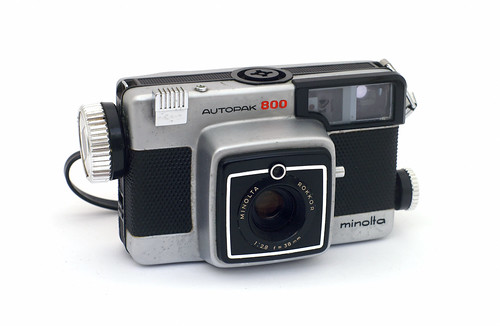Difference between revisions of "Minolta Autopak 800"
m (link) |
(pool CP ->CW; used template for attribution & rights) |
||
| Line 1: | Line 1: | ||
{{Flickr_image | {{Flickr_image | ||
| − | |image_source= http://www.flickr.com/photos/captkodak/271901638/in/pool- | + | |image_source= http://www.flickr.com/photos/captkodak/271901638/in/pool-camerawiki |
|image= http://static.flickr.com/111/271901638_f21afeb822.jpg | |image= http://static.flickr.com/111/271901638_f21afeb822.jpg | ||
| − | |image_align= | + | |image_align= right |
| − | |image_text= click on image | + | |image_text= (click on image for more description) |
| + | |image_by=Steve Harwood | ||
| + | |image_rights=nc | ||
}} | }} | ||
Revision as of 15:58, 27 May 2011

|
| (click on image for more description) image by Steve Harwood (Image rights) |
In 1969, when Neil Armstrong set foot on the Moon, there was a great demand for easy-to-use cameras on Earth that may have been set off some years earlier by Kodak's 126 film cartridge system. The Minolta Autopak 800 was a rangefinder camera for this format. It had a built-in mechanical clockwork motor for automatic film advance that could be wound up - with the knob on the user's right side - for making a series of 12 exposures. Like many other cameras for the format, it had a connector for flashcubes that turned 90 degrees after each exposure to get the next of four bulbs into firing position. Unusually for a 126 camera, the body has both cable release socket and tripod bush.
Specification
- Type: viewfinder film camera
- Manufacturer: Minolta
- Year of launch: 1969
- Film: 126 film cartridge
- Lens: Rokkor 1:2.8/38mm 4-element glass
- Viewfinder: bright frame finder with coupled rangefinder
- Shutter: speeds 1/45 sec. in flash mode, otherwise 1/90 sec.
- Aperture: automatically controlled by CdS light sensor over the lens
- Film advance: clockwork motor
- Dimensions: 125 × 78 × 58mm
- Power: two 825 cells for flash, one PX625 for meter
- Weight: 520 g